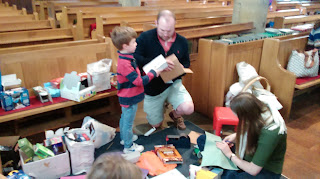The service and activities of Holy Week and Easter help us to “walk through” the last week of Jesus’ earthly ministry as we think together about his arrest, trial, crucifixion and resurrection.
All human life is here; friendship and betrayal, courage and cowardice, suffering and love, loss and new beginnings. These are things we all experience. They are as much a part of our world as they were of Jesus’ world. Reflecting on them helps us to see our own stories, and the challenges we might face in a new way.
Why not come along to some of our Holy Week services this year to join with us in this journey of prayer and meditation?
You will be very welcome.
PALM SUNDAY
10 am Sunday
Our Palm Sunday service begins with a procession from the lychgate, entering the church through the West Doors. We carry palm crosses as we walk, singing a hymn together. When we enter the church the crosses are blessed and we hear the story of Jesus riding into Jerusalem on a donkey a week before he died.
The crowds which shout hosanna and greet him as a king then will soon shout just as loudly for his death, and as the service goes on we begin to think about his coming death.
Instead of a sermon at this service a group of readers share in a dramatised reading the “Passion” story – the account of Jesus trial and crucifixion - this year from Matthew's Gospel.
COMPLINE
8 pm Mon – Sat (not Thurs)
Compline is a short service (about 15 – 20 mins) each evening at 8pm in the Lady Chapel from Monday to Saturday of Holy Week (except Thurs.)
“Compline” means “completion” and it was, and is still, the last service of the day in monasteries, completing the day’s worship. We use a modern form of this ancient service of prayers, psalms, Bible readings and silence. There are no hymns, so you don’t need to worry about singing!
There is some music to listen to beforehand to help us be still, and everything you need for the service is clearly laid out in the service booklet.
It is a reflective, intimate service, ideal if you feel in need of peace and quiet!
MAUNDY THURSDAY
8 pm Thursday
Our Maundy Thursday service is an informal service of Holy Communion, recalling the Last Supper which Jesus shared with his friends on the night before he died.
We hear the story of Jesus washing his disciples’ feet and telling them that they too must be the servants of others. We remember also his words of reassurance to them that whenever they eat bread and drink wine together in the future he will be with them, the origin the Christian practice of Holy Communion in which we share bread and wine.
The service ends as we all go into the Lady Chapel for TENEBRAE. The lights in the church are turned off, except for one at the back for safety. The only other illumination comes from 12 candles on the Lady Chapel altar.
We then hear 12 readings from the Bible, telling the story of Jesus praying in the garden of Gethsemane, of his arrest and trial. After each reading one candle is blown out until we are in darkness, reminding us of the darkness which Jesus faced.
The Maundy Thursday service lasts for just over an hour.
GOOD FRIDAY
MESSY CHURCH FOR GOOD FRIDAY
10 -11.30 am
Craft activities for all ages to help us think about Good Friday and Easter.
We meet in church, where there will be a variety of activities exploring various Holy Week themes. Some of the activities could be quite messy! Wear old clothes!
At around 11 o’clock we break for hot cross buns and a drink, and then we finish with a short, very informal act of worship to share what we have made and thought.
Everyone is welcome, but we can’t take unaccompanied children as we aren’t set up to cater for them. (Actually mums, dads and grandparents usually have as much fun as the children anyway…!)
GOOD FRIDAY SERVICE
2.30 pm Friday
The afternoon service on Good Friday is a mixture of traditional hymns, readings and prayers reflecting on Jesus’ crucifixion. It lasts about 30 – 45 minutes.
During the service we reflect on the meaning of Christ’s death for today and pray for those who suffer from injustice and oppression as he did. There will be a short, reflective talk during the service and a chance to light a candle as your personal prayer.
GOOD FRIDAY REFLECTIVE ACTIVITIES
12 – 8pm Friday
During the afternoon and early evening of Good Friday there will be a number of different reflective “stations” in church. These displays encourage us to reflect and pray on various themes relevant to Holy Week and Easter.
You can drop in at any time and go at your own pace – there will be leaflets to guide you around the stations, but the church is not manned, so you can have privacy to reflect as you want to.
EASTER SUNDAY
Holy Communion and the lighting of the Paschal Candle
10 am
This joyful service of thanksgiving for the Resurrection begins as we light the new Easter (or Paschal) candle, a reminder of the light of Christ which even death could not put out. We light small candles held by the congregation – we all carry that light of Christ out into the world.
EASTER EVENSONG
6.30 pm
A small, traditional said service, with hymns to end Easter Sunday.






































